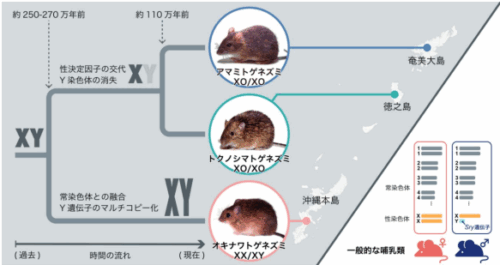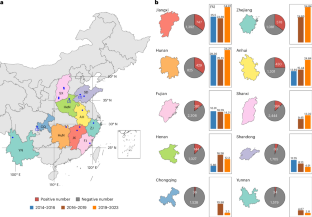2025-06-04 北海道大学,東京科学大学,久留米大学,国立遺伝学研究所,沖縄大学

図 1. トゲネズミの性染色体の特徴と地理的分布、一般的な哺乳類の性染色体の模式図
<関連情報>
- https://www.hokudai.ac.jp/news/2025/06/y.html
- https://www.hokudai.ac.jp/news/pdf/250604_pr.pdf
- https://academic.oup.com/mbe/article/42/5/msaf102/8125831
トゲネズミのY染色体はどこへ行き、どのようにしてそこへたどり着いたのか? Where Did the Y Chromosome in the Spiny Rat Go, and How Did It Get There?
Miki Okuno , Kentaro Matsuoka , Yuta Mochimaru , Takahiro Yamabe , Mayou Okano , Takamichi Jogahara , Atsushi Toyoda , Asato Kuroiwa , Takehiko Itoh
Molecular Biology and Evolution Published:06 May 2025
DOI:https://doi.org/10.1093/molbev/msaf102
Abstract
The XX/XY sex chromosome system is highly conserved across mammals, with rare exceptions where males lack a Y chromosome. Among these is the genus Tokudaia, a group of spiny rats comprising three species with unique sex chromosome systems deviating from the typical XX/XY pattern. While Tokudaia osimensis and Tokudaia tokunoshimensis have completely lost the Y chromosome, they retain some Y-linked genes on the X chromosome. In contrast, Tokudaia muenninki retains large sex chromosomes where both the X and Y chromosomes have fused with an autosome pair, carrying multi-copied Y-linked genes, including Sry. In this study, we generated chromosome-level genome assemblies for male individuals of all three Tokudaia species. By investigating loci typically associated with rodent Y-linked genes, we characterized sequences derived from the Tokudaia Y-chromosomal most recent common ancestor (Tokudaia Y-MRCA) and traced their evolutionary trajectories. Our analyses revealed that an initial X-to-Y translocation of a sequence containing the boundary-associated segmental duplication in a common ancestor of Tokudaia marked the beginning of their unique sex chromosome evolution. The boundary-associated segmental duplication, uniquely multi-copied in Tokudaia, facilitated further rearrangements through nonallelic homologous recombination and duplications. These processes culminated in subsequent Y-to-X translocations and duplications, leading to the complete loss of the Y chromosome as a distinct entity while preserving Y-linked genes in a multicopy state on the X chromosome. These findings highlight Tokudaia‘s rapid sex chromosome evolution within 3 million years and provide insights into the mechanisms underlying Y chromosome loss, contributing to a broader understanding of sex chromosome evolution in rodents.


